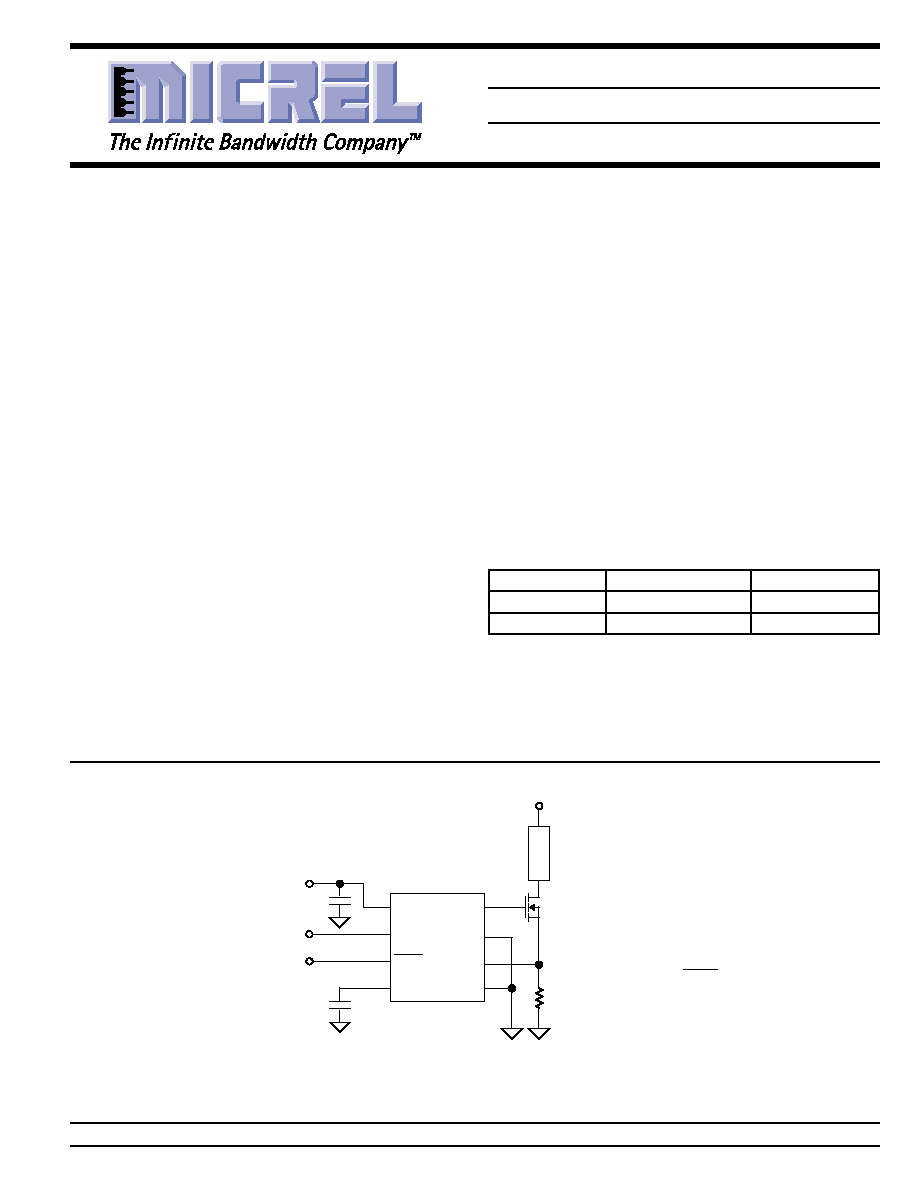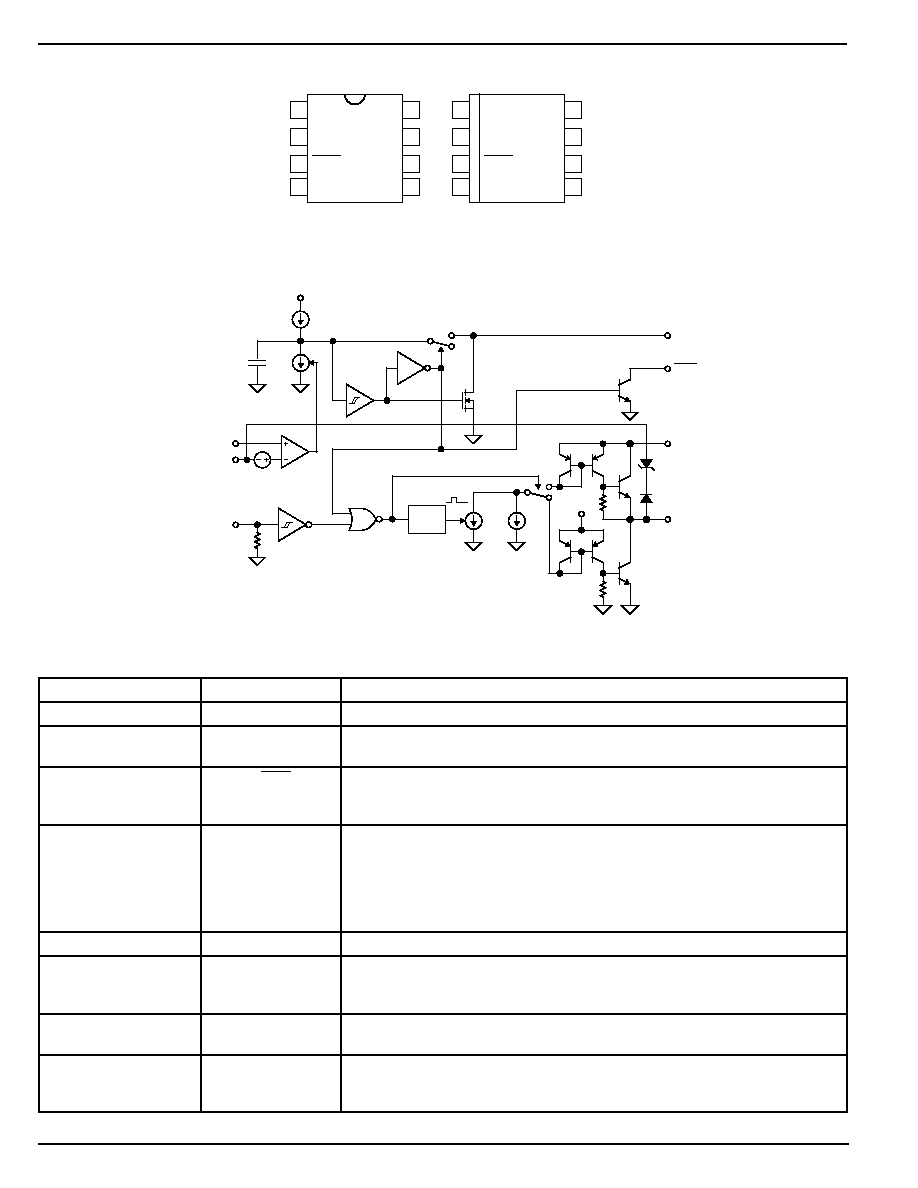 | –≠–ª–µ–∫—Ç—Ä–æ–Ω–Ω—ã–π –∫–æ–º–ø–æ–Ω–µ–Ω—Ç: MIC5020A | –°–∫–∞—á–∞—Ç—å:  PDF PDF  ZIP ZIP |

MIC5020
Micrel
October 1998
1
MIC5020
General Description
The MIC5020 low-side MOSFET driver is designed to oper-
ate at frequencies greater than 100kHz (5kHz PWM for 2% to
100% duty cycle) and is an ideal choice for high-speed
applications such as motor control, SMPS (switch mode
power supplies), and applications using IGBTs. The MIC5020
can also operate as a circuit breaker with or without automatic
retry. The MIC5020's maximum supply voltage lends itself to
control applications using up to 50V. The MIC5020 can
control MOSFETs that switch voltages greater than 50V.
A rising or falling edge on the input results in a current source
or sink pulse on the gate output. This output current pulse can
turn on or off a 2000pF MOSFET in approximately 175ns.
The MIC5020 then supplies a limited current (< 2mA), if
necessary, to maintain the output state.
An overcurrent comparator with a trip voltage of 50mV makes
the MIC5020 ideal for use with a current sensing MOSFET.
An external low value resistor may be used instead of a
sensing MOSFET for more precise overcurrent control. An
optional external capacitor connected to the C
T
pin may be
used to control the current shutdown duty cycle from 20% to
< 1%. A duty cycle from 20% to about 75% is possible with
an optional pull-up resistor from C
T
to V
DD
. An open collector
output provides a fault indication when the sense inputs are
tripped.
The MIC5020 is available in 8-pin SOIC and plastic DIP
packages.
Other members of the MIC502x series include the MIC5021
high-side driver and the MIC5022 half-bridge driver with a
cross-conduction interlock.
MIC5020
Current-Sensing Low-Side MOSFET Driver
Final Information
Ordering Information
Part Number
Temperature Range
Package
MIC5020BM
≠40
∞
C to +85
∞
C
8-pin SOIC
MIC5020BN
≠40
∞
C to +85
∞
C
8-pin Plastic DIP
Low-Side Driver with Overcurrent Trip and Retry
Features
∑ 11V to 50V operation
∑ 175ns rise/fall time driving 2000pF
∑ TTL compatible input with internal pull-down resistor
∑ Overcurrent limit
∑ Fault output indication
∑ Gate to source protection
∑ Compatible with current sensing MOSFETs
Applications
∑ Lamp control
∑ Heater control
∑ Motor control
∑ Solenoid switching
∑ Switch-mode power supplies
∑ Circuit breaker
Typical Application
V
DD
Input
Fault
C
T
Gate
Sense
-
Sense
+
Gnd
150kHz max.
N-Channel
Power MOSFET
V+
MIC5020
1
2
3
4
8
7
6
5
10µF
Load
R
SENSE
+11V to +50V
R
SENSE =
50mV
I
TRIP
* increases time before retry
optional*
Micrel, Inc. ∑ 1849 Fortune Drive ∑ San Jose, CA 95131 ∑ USA ∑ tel + 1 (408) 944-0800 ∑ fax + 1 (408) 944-0970 ∑ http://www.micrel.com

MIC5020
Micrel
MIC5020
2
October 1998
Pin Description
Pin Number
Pin Name
Pin Function
1
V
DD
Supply: +11V to +50V. Decouple with
10
µ
F capacitor.
2
Input
TTL Compatible Input: Logic high turns the external MOSFET on. An internal
pull-down returns an open pin to logic low.
3
Fault
Overcurrent Fault Indicator: When the sense voltage exceeds threshold,
open collector output is open circuit for 5
µ
s (t
G(ON)
), then pulled low for
t
G(OFF)
. t
G(OFF)
is adjustable from C
T
.
4
C
T
Retry Timing Capacitor: Controls the off time (t
G(OFF)
) of the overcurrent
retry cycle. (Duty cycle adjustment.)
∑ Open = 20% duty cycle.
∑ Capacitor to Ground = approx. 20% to <1% duty cycle.
∑ Pull-Up resistor = approx. 20% to approx. 75% duty cycle.
∑ Ground = maintained shutdown upon overcurrent condition.
5
Gnd
Circuit Ground
6
Sense +
Current Sense Comparator (+) Input: Connect to high side of sense resistor
or current sensing MOSFET sense lead. A built-in offset in conjunction with
R
SENSE
sets the load overcurrent trip point.
7
Sense ≠
Current Sense Comparator (≠) Input: Connect to the low side of the sense
resistor (usually power ground).
8
Gate
Gate Drive: Drives the gate of an external power MOSFET. Also limits V
GS
to 15V max. to prevent Gate to Source damage. Will sink and source
current.
Pin Configuration
1
2
3
4
8
7
6
5
V
DD
Input
Fault
C
T
Gate
Sense
-
Sense
+
Gnd
1
2
3
4
8
7
6
5
Gate
Sense
-
Sense
+
Gnd
V
DD
Input
Fault
C
T
Block Diagram
Sense ≠
Sense +
6V Internal Regulator
C
INT
I
1
2I
1
50mV
Input
ONE-
SHOT
V
DD
Gate
Fault
C
T
6V
OFF
ON
Fault
Normal
I
2
10I
2
Q1
Transistor Count: 82
DIP Package
SOIC Package
(N)
(M)

MIC5020
Micrel
October 1998
3
MIC5020
Electrical Characteristics
T
A
= 25
∞
C, Gnd = 0V, V
DD
= 12V, Sense +,≠ = 0V, Fault = Open, C
T
= Open, Gate C
L
= 1500pF unless otherwise specificed
Symbol
Parameter
Condition
Min
Typ
Max
Units
D.C. Supply Current
V
DD
= 12V, Input = 0V
0.8
2
mA
V
DD
= 50V, Input = 0V
2
10
mA
V
DD
= 12V, Input = 5V
0.8
2
mA
V
DD
= 50V, Input = 5V
4
25
mA
Input Threshold
0.8
1.4
2.0
V
Input Hysteresis
0.1
V
Input Pull-Down Current
Input = 5V
10
20
40
µ
A
Fault Output
Fault Current = 1.6mA
0.15
0.4
V
Saturation Voltage
Note 1
Fault Output Leakage
Fault = 50V
≠1
0.01
+1
µ
A
Current Limit Threshold
Note 2
30
50
70
mV
Gate On Voltage
V
DD
= 12V
10
11
V
V
DD
= 50V
14
15
18
V
t
G(ON)
Gate On Time, Fixed
Sense Differential > 70mV
2
5
10
µ
s
t
G(OFF)
Gate Off Time, Adjustable
Sense Differential > 70mV, C
T
= 0pF
10
20
50
µ
s
t
DLH
Gate Turn-On Delay
Note 3
400
800
ns
t
R
Gate Rise Time
Note 4
700
1500
ns
t
DLH
Gate Turn-Off Delay
Note 5
900
1500
ns
t
F
Gate Fall Time
Note 6
500
1500
ns
f
max
Maximum Operating Frequency
Note 7
100
150
kHz
Note 1
Voltage remains low for time affected by C
T
.
Note 2
When using sense MOSFETs, it is recommended that R
SENSE
< 50
. Higher values may affect the sense MOSFET's current transfer ratio.
Note 3
Input switched from 0.8V (TTL low) to 2.0V (TTL high), time for Gate transition from 0V to 2V.
Note 4
Input switched from 0.8V (TTL low) to 2.0V (TTL high), time for Gate transition from 2V to 10V.
Note 5
Input switched from 2.0V (TTL high) to 0.8V (TTL low), time for Gate transition from 11V (Gate ON voltage) to 10V.
Note 6
Input switched from 2.0V (TTL high) to 0.8V (TTL low), time for Gate transition from 10V from 2V.
Note 7
Frequency where gate on voltage reduces to 10V with 50% input duty cycle.
Absolute Maximum Ratings
Supply Voltage (V
DD
) .................................................. +55V
Input Voltage ................................................ ≠0.5V to +15V
Sense Differential Voltage ..........................................
±
6.5V
Sense + or Sense ≠ to Gnd .......................... ≠0.5V to +50V
Fault Voltage ............................................................... +50V
Current into Fault ....................................................... 50mA
Timer Voltage (C
T
) ..................................................... +5.5V
Operating Ratings
Supply Voltage (V
DD
) .................................... +11V to +50V
Temperature Range
SOIC ...................................................... ≠40
∞
C to +85
∞
C
Plastic DIP .............................................. ≠40
∞
C to +85
∞
C

MIC5020
Micrel
MIC5020
4
October 1998
0.5
1.0
1.5
2.0
2.5
3.0
3.5
5 10 15 20 25 30 35 40 45 50
I
SUPPLY
(mA)
V
SUPPLY
(V)
Supply Current vs.
Supply Voltage
V
IN
= 5V
V
IN
= 0V
700
800
900
1000
1100
1200
5
10
15
20
25
30
t
OFF
(ns)
V
SUPPLY
(V)
Turn-Off Time vs.
Supply Voltage
V
GATE
= 4V
C
L
= 1500pF
V
IN
= 0 to 5V
Sq. Wave
INCLUDES PROPAGATION DELAY
0
20
40
60
80
100
0
5
10
15
20
25
I
IN
(
µ
A)
V
IN
(V)
Input Current vs.
Input Voltage
V
SUPPLY
= 12V
200
400
600
800
1000
1200
1x10
2
1x10
3
1x10
4
1x10
5
t
ON
(ns)
C
GATE
(pF)
Turn-On Time vs.
Gate Capacitance
V
GATE
= 4V
INCLUDES PROPAGATION DELAY
0.0
5.0
10.0
15.0
20.0
25.0
0.1
1
10
100
1000 10000
Shutdown Duty Cycle (%)
C
T
(pF)
t
ON
= 5
µ
s
V
SUPPLY
= 12V
Overcurrent Shutdown
Retry Duty Cycle
Typical Characteristics
400
500
600
700
800
900
5 10 15 20 25 30 35 40 45 50
t
ON
(nS)
V
SUPPLY
(V)
Turn-On Time vs.
Supply Voltage
V
GATE
= 4V
C
L
= 1500pF
V
IN
= 0 to 5V Sq. Wave
INCLUDES PROPAGATION DELAY
Input
0V
TTL (H)
0V
50mV
Sense +, ≠
Differential
Gate
Fault
0V
15V (max.)
Off
On
5µs
20µs
Input
0V
TTL (H)
0V
50mV
Sense +, ≠
Differential
Gate
Fault
0V
15V (max.)
Off
On
5µs
Input
0V
TTL (H)
0V
50mV
Sense +, ≠
Differential
Gate
Fault
0V
15V (max.)
Off
On
20
30
40
50
60
70
80
-60 -30
0
30
60
90 120 150
VOLTAGE (mV)
TEMPERATURE (
∞
C)
Sense Threshold vs.
Temperature
Timing Diagram 2. Fault Condition, C
T
= Open
Timing Diagram 3. Fault Condition, C
T
= Grounded
Timing Diagram 1. Normal Operation

MIC5020
Micrel
October 1998
5
MIC5020
source side sensing is provided by access to both
SENSE
+
and
SENSE
≠ comparator inputs.
The adjustable retry feature can be used to handle loads with
high initial currents, such as lamps, motors, or heating
elements and can be adjusted from the C
T
connection.
C
T
to ground causes maintained gate drive shutdown follow-
ing overcurrent detection.
C
T
open, or through a capacitor to ground, causes automatic
retry . The default duty cycle (C
T
open) is approximately 20%.
Refer to the electrical characteristics when selecting a ca-
pacitor for a reduced duty cycle.
C
T
through a pull-up resistor to V
DD
increases the duty cycle.
Increasing the duty cycle increases the power dissipation in
the load and MOSFET. Circuits may become unstable at a
duty cycles of about 75% or higher, depending on the
conditions.
Caution: The MIC5020 may be damaged if the
voltage on C
T
exceeds the absolute maximum rating.
An overcurrent condition is externally signaled by an open
collector (
FAULT
) output.
The MIC5020 may be used without current sensing by
connecting
SENSE
+ and
SENSE
≠ to ground.
Current Sense Resistors
Lead length can be significant when using low value (< 1
)
resistors for current sensing. Errors caused by lead length
can be avoided by using four-terminal current sensing resis-
tors. Four-terminal resistors are available from several
manufacturers.
Applications Information
The MIC5020 MOSFET driver is intended for low-side switch-
ing applications where higher supply voltage, overcurrent
sensing, and moderate speed are required.
Supply Voltage
A feature of the MIC5020 is that its supply voltage rating of up
to 50V is higher than many other low-side drivers.
The minimum supply voltage required to fully enhance an N-
channel MOSFET is 11V.
A lower supply voltage may be used with logic level MOSFETs.
Approximately 6V is needed to provide 5V of gate enhance-
ment.
Low-Side Switch Circuit Advantages
A moderate-speed low-side driver is generally much faster
than a comparable high-side driver. The MIC5020 can
provide the gate drive switching times and low propagation
delay times that are necessary for high-frequency high-
efficiency circuit operation in PWM (pulse width modulation)
designs used for motor control, SMPS (switch mode power
supply) and heating element control. Switched loads (on/off)
can benefit from the MIC5020's fast switching times by
allowing use of MOSFETs with smaller safe operating areas.
(Larger MOSFETs are often required when using slower
drivers.)
Overcurrent Limiting
A 50mV comparator is provided for current sensing. The low
level trip point minimizes I
2
R losses when power resistors are
used for current sensing. Flexibility in choosing drain or
Functional Description
Refer to the MIC5020 block diagram.
Input
A signal greater than 1.4V (nominal) applied to the MIC5020
INPUT
causes gate enhancement on an external MOSFET
turning the external MOSFET on.
An internal pull-down resistor insures that an open
INPUT
remains low, keeping the external MOSFET turned off.
Gate Output
Rapid rise and fall times on the
GATE
output are possible
because each input state change triggers a one-shot which
activates a high-value current sink (10I
2
) for a short time. This
draws a high current through a current mirror circuit causing
the output transistors to quickly charge or discharge the
external MOSFET's gate.
A second current sink continuously draws the lower value of
current used to maintain the gate voltage for the selected
state.
An internal 15V Zener diode protects the external MOSFET
by limiting the gate output voltage when V
DD
is connected to
higher voltages.
Overcurrent Limiting
Current source I
1
charges C
INT
upon power up. An optional
external capacitor connected to C
T
is discharged through
MOSFET Q1.
A fault condition (> 50mV from
SENSE
+ to
SENSE
≠) causes
the overcurrent comparator to enable current sink 2I
1
which
overcomes current source I
1
to discharge C
INT
in a short time.
When C
INT
is discharged, the
INPUT
is disabled, which turns
off the
GATE
output; the
FAULT
output is enabled; and C
INT
and C
T
are ready to be charged.
When the
GATE
output turns the MOSFET off, the overcurrent
signal is removed from the sense inputs which deactivates
current sink 2I
1
. This allows C
INT
and the optional capacitor
connected to C
T
to recharge. A Schmitt trigger delays the
retry while the capacitor(s) recharge. Retry delay is in-
creased by connecting a capacitor to C
T
(optional).
The retry cycle will continue until the the fault is removed or
the input is changed to TTL low.
If C
T
is connected to ground, the circuit will not retry upon a
fault condition.
Fault Output
The
FAULT
output is an open collector transistor.
FAULT
is
active at approximately the same time the output is disabled
by a fault condition (5
µ
s after an overcurrent condition is
sensed). The
FAULT
output is open circuit (off) during each
successive retry (5
µ
s).




